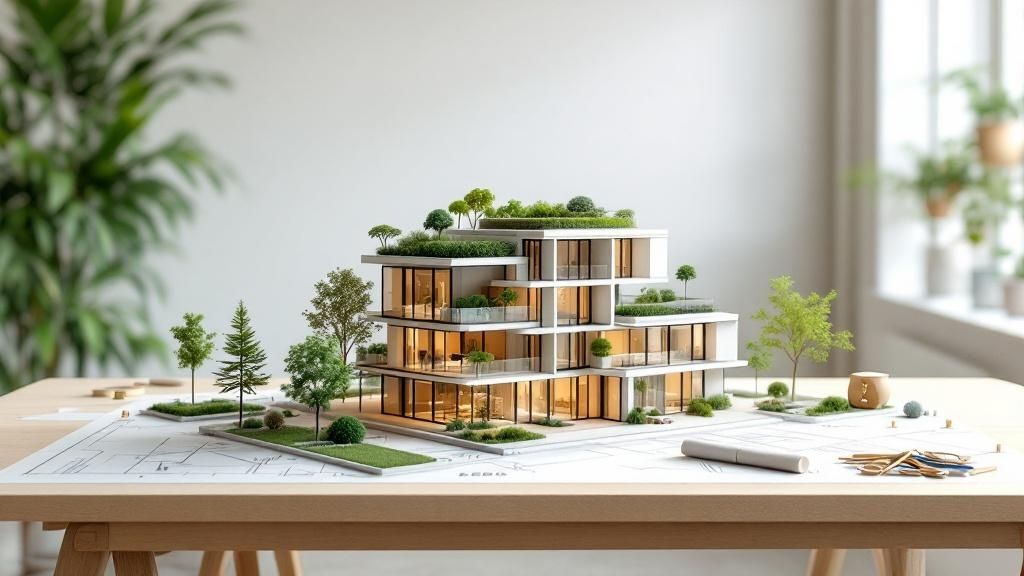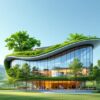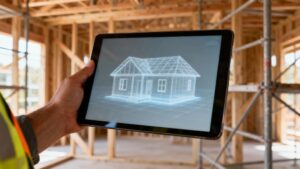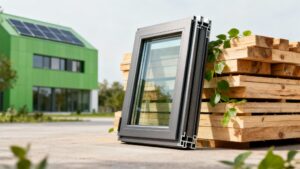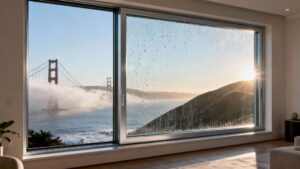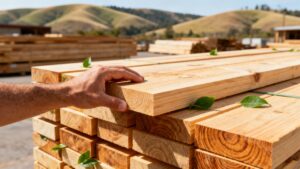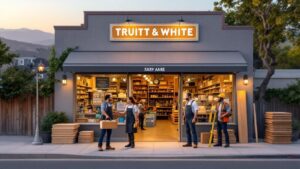If you're a builder, architect, or homeowner in the Bay Area, you’ve almost certainly heard the term LEED. But what does it actually mean for your projects?
Put simply, LEED (Leadership in Energy and Environmental Design) is the most widely used green building rating system in the world. Developed by the U.S. Green Building Council (USGBC), it provides a framework for creating buildings that are healthy, highly efficient, and better for our environment.
Think of it like a nutrition label for a building. It offers a clear, verifiable scorecard showing how a project performs across key sustainability metrics.
Why LEED Matters for Bay Area Construction Projects
For professionals and homeowners here in the Bay Area, understanding LEED is no longer optional—it's essential for modern construction. This isn't just about winning an award. It’s a comprehensive system that guides a project from initial design and construction all the way through to operation and maintenance.
At its core, the LEED framework is built on a point system. Projects earn credits by implementing specific sustainable strategies, from using recycled Berkeley building materials to installing water-saving fixtures.
The goal is to create structures that are better for the planet and for the people inside them. LEED encourages a holistic approach that balances environmental responsibility with real-world benefits like lower utility bills and healthier indoor air.
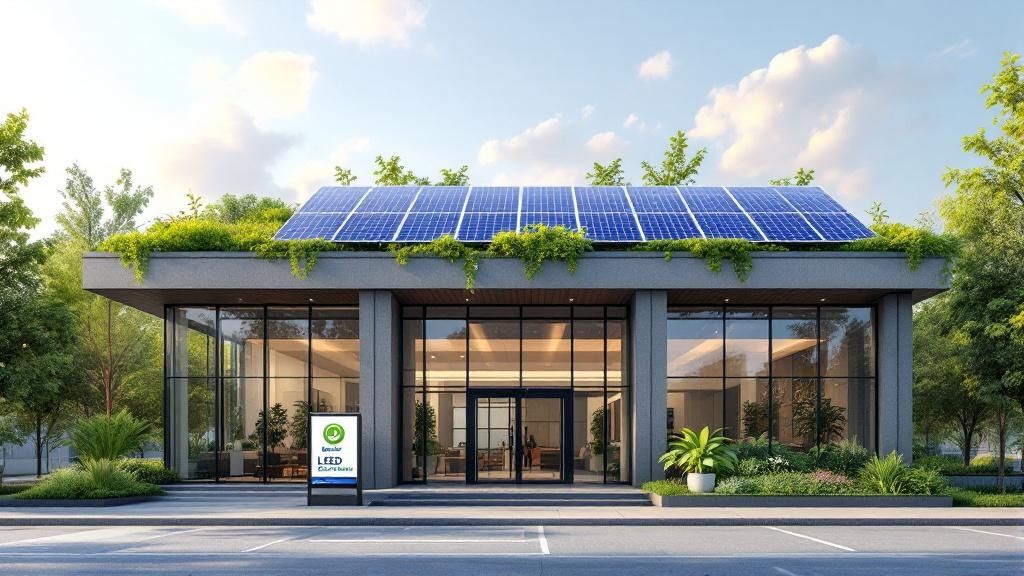
Image Caption: The LEED framework is flexible enough to guide sustainable practices for any project, from a Berkeley home remodel to a new commercial high-rise in San Francisco. Alt Text: Diagram from the U.S. Green Building Council showing the different types of projects that can achieve LEED certification.
To help break it down, here’s a quick overview of the essential parts of the LEED framework.
LEED Certification at a Glance: Key Components
This table shows how LEED provides a structured yet flexible path for any project team looking to build more responsibly.
| Component | Description |
|---|---|
| Rating Systems | Different versions of LEED are tailored for specific project types, like New Construction, Existing Buildings, or Interior Design. |
| Credit Categories | Projects earn points across several key areas, such as energy, water efficiency, materials, and indoor environmental quality. |
| Prerequisites | These are mandatory practices that every LEED project must satisfy to even be considered for certification. |
| Points & Levels | Based on the total points achieved, a project can earn one of four certification levels: Certified, Silver, Gold, or Platinum. |
The Global Impact of LEED
Since its creation over 25 years ago, LEED has become a global benchmark for sustainability.
According to the USGBC, more than 197,000 projects across 186 countries have now earned certification. On average, these buildings use 25% less energy and 11% less water than their conventional counterparts.
By providing a clear and verifiable standard, LEED helps project teams in places like Berkeley and Oakland create buildings that are measurably better—reducing operational costs, conserving resources, and enhancing occupant health.
For anyone committed to forward-thinking construction, exploring green building practices is the natural first step. The principles behind LEED are a perfect match for the Bay Area's deep-rooted culture of environmental leadership and innovation.
Understanding the LEED Rating System and Certification Levels
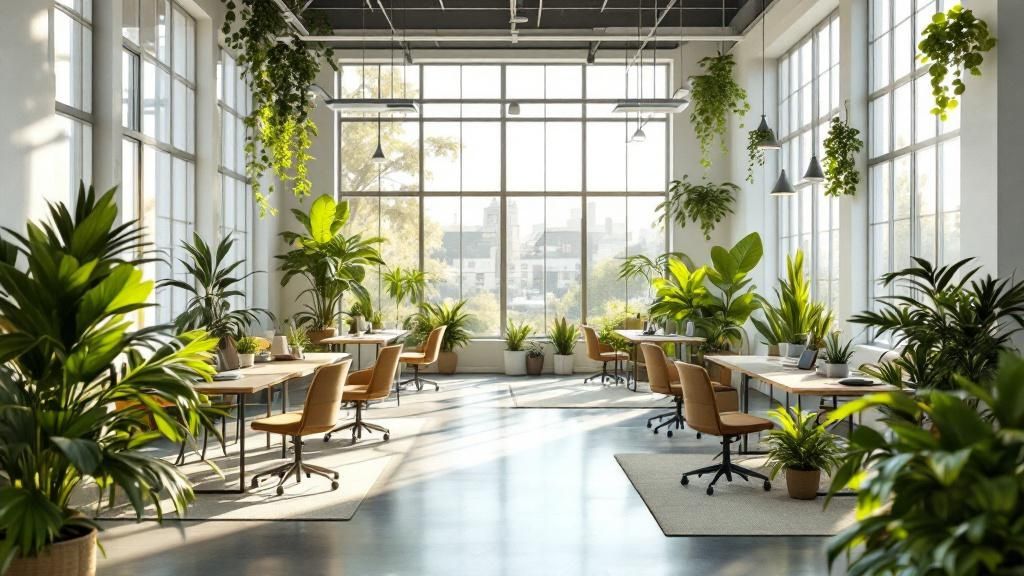
Image Caption: A modern building with large, energy-efficient windows, a key component for earning points in LEED's Energy and Atmosphere category. Alt Text: A contemporary building featuring sustainable architectural design and large windows, exemplifying LEED principles.
The first thing to know about LEED is that it isn’t a one-size-fits-all checklist. It’s a flexible collection of rating systems designed to tackle the unique challenges of different projects. The green building standards for a new skyscraper in San Francisco should be different from those for a tenant improvement in a Berkeley office.
This adaptability is what makes the LEED certification so effective. The framework provides specific "rulebooks" tailored to the job at hand, ensuring sustainability goals are always relevant.
Each rating system is purpose-built to guide project teams toward the most impactful green strategies for their specific context.
Different LEED Systems for Different Projects
The U.S. Green Building Council (USGBC) has developed several distinct rating systems to cover a building's entire lifecycle. For contractors and architects in the Bay Area, these are especially common:
- Building Design and Construction (BD+C): This is the go-to for new construction or major gut renovations, applying to everything from a custom home in Oakland to a massive commercial office tower.
- Interior Design and Construction (ID+C): This system focuses on what’s inside—specifically, commercial interior fit-outs for businesses aiming for a sustainable and healthy work environment.
- Operations and Maintenance (O+M): Geared toward existing buildings, this helps property owners and managers improve performance and shrink their environmental footprint without major construction.
- Homes: This rating system is specifically designed for single-family homes and low- to mid-rise multi-family residential projects.
By picking the right system from the start, your project team can focus on strategies that make the most sense.
The Four Tiers of LEED Achievement: Certified, Silver, Gold, and Platinum
Once a project is registered, it earns points by meeting various sustainability criteria. The total number of points determines which of the four certification levels it achieves. This tiered structure gives teams a clear benchmark for performance.
Each level represents a greater commitment to sustainable practices. This point-based approach transforms the abstract goal of "building green" into a concrete, measurable process of achievement.
The point breakdown is straightforward. Here’s a quick look at what it takes to hit each level:
LEED Certification Levels and Point Thresholds
| Certification Level | Points Required (out of 110 total) |
|---|---|
| Certified | 40–49 points |
| Silver | 50–59 points |
| Gold | 60–79 points |
| Platinum | 80+ points |
Earning a Certified status shows a solid foundation in green building. Reaching for Silver, Gold, or the prestigious Platinum level signals that a project is a true leader in sustainability for the Bay Area and beyond.
The Key Benefits of LEED Certification for Bay Area Projects
Pursuing LEED certification is about more than just getting a plaque for the wall. It delivers real, measurable advantages for any construction project in the Bay Area, impacting everything from the financial bottom line to the health of the people who will live and work inside.
For builders and architects working everywhere from Berkeley to Oakland, understanding these perks makes a powerful business case for sustainable design. The decision to build green is a smart investment that pays off in three key areas: financial performance, community impact, and occupant wellbeing.
Benefit #1: Improved Financial Performance
While green buildings can have higher upfront costs, the long-term financial picture tells a different story. LEED-certified buildings are engineered for efficiency, which translates directly to lower operational expenses year after year.
According to the USGBC, LEED buildings report nearly 20% lower maintenance costs than typical commercial buildings. They also use 25% less energy and 11% less water, creating immediate and ongoing savings on utility bills.
In a high-cost market like the San Francisco Bay Area, lower operating expenses and higher tenant demand mean LEED buildings often command premium rental rates and hold their value better over time.
On top of operational savings, incentives can make a LEED project even more financially attractive. Taking advantage of programs like federal solar tax credits can significantly reduce the cost of incorporating renewable energy.
Benefit #2: Positive Environmental and Community Impact
LEED projects are a perfect match for California's ambitious climate goals. By demanding resource efficiency, these buildings reduce the strain on our local infrastructure and natural habitats.
- Smaller Carbon Footprint: LEED projects are a key tool in the fight against climate change, with an average CO2 emissions reduction of 34% compared to conventional buildings.
- Serious Water Conservation: In a state familiar with drought, the focus on water-efficient landscaping and fixtures helps preserve one of our most precious resources.
- Smarter Materials: Prioritizing responsible sourcing supports a healthier, more sustainable supply chain. You can explore a wide range of sustainable building materials for Bay Area projects that help earn valuable LEED credits.
Benefit #3: Enhanced Occupant Health and Wellbeing
This might be the most important benefit of all: LEED buildings are simply healthier places to be. The standards put a huge emphasis on human health.
Thanks to better ventilation and the required use of low-VOC paints, sealants, and flooring, occupants report fewer health issues related to poor indoor air quality. This commitment to wellness translates into higher productivity, fewer sick days, and a greater sense of satisfaction for everyone inside.
A Step-by-Step Guide to the LEED Certification Process
For builders and architects in the Bay Area, the journey to LEED certification can seem intimidating. However, the process is structured and manageable, like following a well-drawn blueprint with clear milestones.
The entire process is managed by Green Business Certification Inc. (GBCI). They are the independent, third-party group that handles verification for every LEED project, ensuring that green claims are backed by hard, verifiable data.
The Key Stages of Certification
Nailing a LEED certification comes down to a methodical approach. From the first planning meeting to the final approval, each step builds on the last. A smooth certification journey typically follows these key phases.
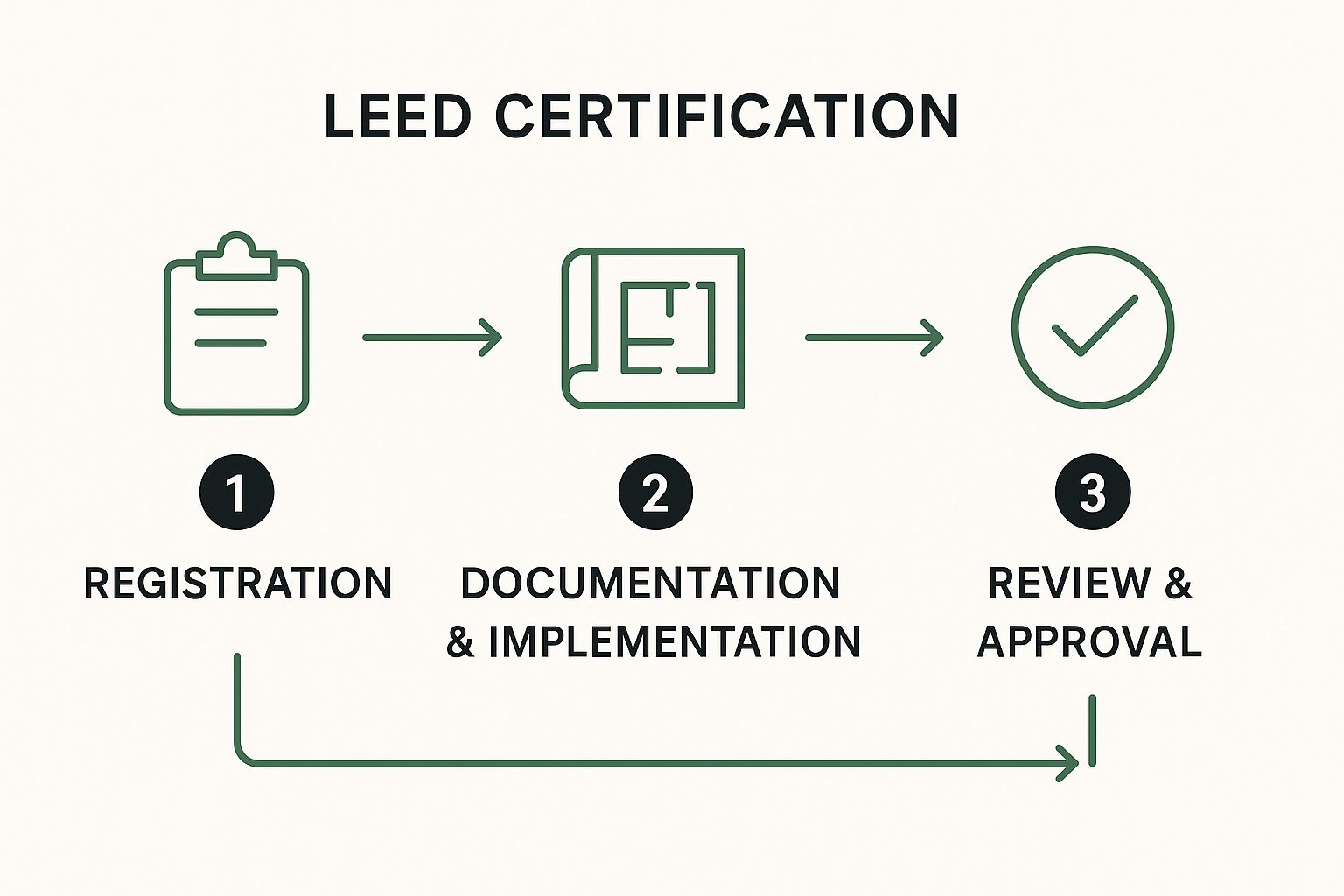
Image Caption: The LEED certification process follows a clear path from project registration to final review and award. Alt Text: A flowchart illustrating the main stages of the LEED certification process: registration, documentation, submission, and final certification.
Here’s a more detailed breakdown of what you can expect:
- Project Registration: The first official move is registering your project on LEED Online. This is where you declare your intent to pursue certification and gain access to the tools needed to manage documentation.
- Data Collection and Documentation: This is where the real work happens. Your team will gather and submit all evidence—from energy calculations and material specifications to construction plans—that proves you’ve met the targeted prerequisites and credits.
- Submission and Review: Once documentation is complete, you submit the application to the GBCI. A reviewer will assess everything and provide feedback, which might include requests for more information or clarification.
- Final Certification: After a successful review, the GBCI officially awards the project its LEED certification. This comes with a formal certificate and plaque recognizing your achievement.
The Value of a LEED Accredited Professional (AP)
Want the secret to a smooth process? Involve a LEED Accredited Professional (AP) from day one. A LEED AP is an expert who knows the rating systems and certification process inside and out.
They act as your project’s guide, helping the team pinpoint effective green strategies and steer clear of common documentation mistakes. For contractors, it's also crucial to partner with suppliers who understand the demands of high-performance construction. Learn more in our guide on why Oakland contractors choose Truitt & White in Berkeley.
The LEED Credit Categories Explained
So, how does LEED actually measure a building's performance? It all comes down to the credit categories. Think of them as subjects on a project's report card. A project earns points in each category, and the total determines its final certification level.
These categories create a complete framework, ensuring a project addresses sustainability from every angle. Let's break down the core categories that Bay Area builders and architects work with every day.
Sustainable Sites and Water Efficiency
These two categories focus on how a building interacts with its immediate surroundings. The goal is to reduce the negative impact of construction on the local ecosystem and, critically for us in California, our water resources.
- Sustainable Sites (SS): This category rewards smart site selection and design. For example, a project in Oakland could score points by being built near public transit, reducing car dependency. Other points are awarded for managing stormwater runoff or using reflective roofing to fight the "heat island" effect.
- Water Efficiency (WE): This is a huge deal in California. The WE category is all about using water more intelligently. Points are awarded for installing low-flow fixtures, landscaping with native, drought-tolerant plants, and setting up systems to harvest rainwater.
Energy and Atmosphere
This is one of the heavy hitters in the LEED system. The Energy and Atmosphere (EA) category focuses on cutting energy use, boosting efficiency, and switching to renewable power.
For any project in the Bay Area, this could be as straightforward as specifying high-performance windows to minimize solar heat gain. For projects aiming for top certification levels, incorporating innovative solar energy solutions is a game-changer.
This category is where a building's carbon footprint gets put under the microscope. Every point earned here translates to real savings in energy costs and a reduction in greenhouse gas emissions, aligning perfectly with California's climate goals.
Materials and Resources
The Materials and Resources (MR) category shifts the focus to the physical materials that go into a building. It encourages builders to use sustainable materials and reduce construction waste.
A few strategies to earn points here include:
- Specifying products with high recycled content.
- Sourcing materials manufactured locally in the Bay Area to slash transportation emissions.
- Implementing a solid construction waste management plan to divert materials from landfills.
Indoor Environmental Quality
A green building isn't just good for the planet; it must be good for the people inside it. The Indoor Environmental Quality (IEQ) category is all about making the indoor space healthier, more comfortable, and more productive.
You earn points by using low-VOC (volatile organic compound) paints, adhesives, and flooring to keep indoor air clean. Other credits are given for maximizing natural daylight, giving occupants control over their thermal comfort, and ensuring top-notch ventilation. Our guide on choosing energy-efficient windows is a great resource for selecting products that improve both energy numbers and occupant well-being.
LEED in the Bay Area: Exceeding California's High Standards
While LEED is a global benchmark, its principles have taken deep root right here in the Bay Area. Its worldwide adoption gives it credibility, but its local application makes it a powerful tool for builders, architects, and homeowners from San Francisco to Berkeley.
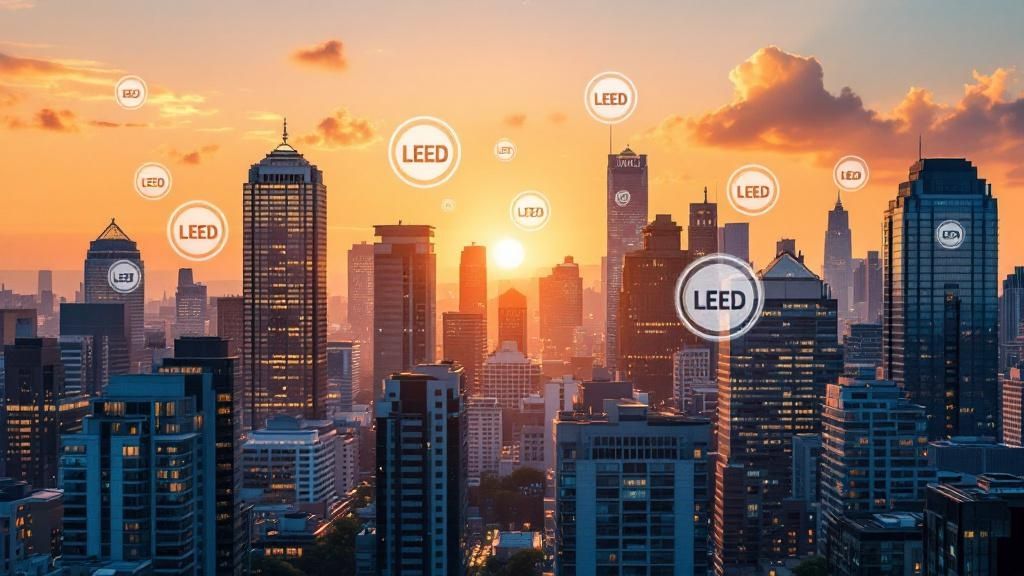
Image Caption: The San Francisco skyline, where many buildings have achieved LEED certification to meet the Bay Area's high standards for sustainability. Alt Text: A photo of the San Francisco skyline at dusk, highlighting the prevalence of modern, sustainable architecture.
The growth of LEED speaks for itself. The United States leads with the most certified projects, but major economies like China have also embraced the standard, as detailed in the USGBC's global green building trends. This international buy-in proves that LEED is the gold standard for green construction.
Going Beyond California's Title 24 Energy Code
Here in California, sustainable building isn’t just a nice-to-have; it's practically written into our DNA. The state's Title 24 energy code already sets one of the highest bars in the nation for building performance. So, why bother with LEED?
Think of it this way: Title 24 is the minimum passing grade. Pursuing LEED certification gives project teams a roadmap to not just meet those stringent requirements, but to blow past them. It's the path to getting an A+ by creating buildings that are more efficient, healthier, and ultimately more valuable.
For a contractor in Oakland or a developer in San Francisco, achieving LEED Gold or Platinum is a clear differentiator. It signals a commitment to quality and forward-thinking design that resonates with the environmentally conscious buyers and tenants across the Bay Area.
By using the LEED system, Bay Area professionals can deliver properties that aren't just compliant, but truly exceptional. This commitment reinforces our region's reputation as a leader in both tech and environmental innovation.
Frequently Asked Questions About LEED Certification
Here are answers to some of the most common questions builders, architects, and homeowners have about LEED in the Bay Area.
1. Is LEED certification mandatory in California?
No, LEED certification itself is not a statewide mandate for most private projects in California. However, many Bay Area cities like Berkeley, Oakland, and San Francisco have their own green building ordinances that often align closely with LEED standards, making certification a practical pathway to compliance.
2. How much does it cost to get a building LEED certified?
The cost varies significantly based on project size, type, and the target certification level (Certified, Silver, Gold, or Platinum). Fees include registration, review, and potential consultant costs, but these are often offset by long-term operational savings from reduced energy and water bills.
3. What is the difference between LEED and GreenPoint Rated?
LEED is a globally recognized standard for all building types, whereas GreenPoint Rated is a California-specific standard focused primarily on residential construction. Both are excellent rating systems, and the best choice depends on your project’s goals, location, and target market.
4. Can an existing building become LEED certified?
Yes, absolutely. The LEED for Operations and Maintenance (O+M) rating system is designed specifically for existing buildings. It focuses on improving day-to-day performance in areas like energy efficiency, waste management, and indoor air quality without requiring a major renovation.
5. What are the main benefits of getting LEED certified?
The key benefits are threefold: financial, environmental, and health-related. LEED buildings have lower operating costs, a smaller environmental footprint, and provide healthier indoor spaces for occupants, which can lead to increased property value and tenant demand, especially in the Bay Area market.
Whether you're specifying materials for a LEED Platinum project or simply want expert advice on sustainable building, Truitt & White has the products and knowledge to support your success. Visit our Berkeley showroom to speak with an expert today.


